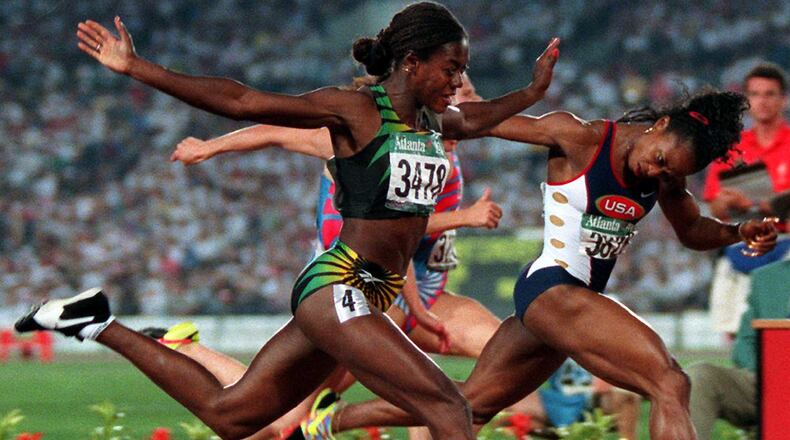On the 25th anniversary of the 1996 Atlanta Olympic Games, The Atlanta Journal-Constitution presents a series of retrospectives produced by the University of Georgia’s Carmical Sports Media Institute. The Eyewitness to History interviews offer the view of someone who was at a top moment on the Summer Games.
Gail Devers once told Atlanta Magazine that she didn’t know whether she’d “be able to walk again, let alone run” when radiation treatment for Graves’ disease, an autoimmune disorder that causes hyperthyroidism, dangerously swelled her feet. Devers not only returned to the track but won the 100 meters at the Barcelona 1992 Olympic Games.
Her win at the Atlanta Olympic Games made her only the second woman to successfully defend an Olympic 100-meter title. Wyomia Tyus first accomplished the feat in 1964 and 1968.
Devers’ 1992 victory came in a photo finish, and the 1996 race was almost an exact replica of the 1993 world championships. In both races, Devers and Jamaica’s Merlene Ottey appeared to finish at the same time and didn’t immediately know who had won. Judges determined that Devers won both.
Andy Rosenberg watched Devers’ 1996 win from the press box in Centennial Olympic Stadium. An NBC director for 12 Olympic Games, Rosenberg was in charge of choosing the camera angles for the national audience tuned in to the drama.
“She had this little legacy of very, very close finishes determined by photos and so now it comes to the 100-meter final in Atlanta. It’s her, Merlene Ottey and (the USA’s) Gwen Torrence, who was there in the other races. Then Gail jumps out of the blocks and really is way ahead. She’s got space between her and the other runners.
“Ottey, running next to Devers in the fourth lane, closed the gap in the final seconds of the race. Torrence looked to be about even with Ottey but leaned toward the finish line a few moments too early. Devers, meanwhile, dipped her head and right shoulder at the perfect time. NBC announcer Tom Hammond called it ‘that lean, that familiar lean.’
“(Replay officials use) a high-speed camera that produces an image that shows when a person’s torso crosses the line, because that’s what it is. It’s not your hand, it’s not your face, it’s not your legs. It’s your torso crossing the line to determine the winner.
“Gail had an uncanny ability to know how to lean and when to lean. Because if you lean too early, as Gwen did in this race, you lose speed, you need to lean just as you cross the finish line. There’s a technique to it and a timing, because it’s a very precise kind of thing to do it well.
“You could pick up maybe an inch, two inches. But an inch or two inches in a photo finish is the difference of winning and losing.
Credit: AP
Credit: AP
“It does not take away from (Devers’) greatness as a runner. Because she had to get down there to be close enough to lean.
“About one minute passed between the end of the race and the public address announcer declaring Devers to be the winner. During that time, Rosenberg ensured that viewers witnessed the sprinters’ full range of emotions.
“That time for me is one of showing both athletes, showing the concern on their faces. Because it’s either gold or silver. Silver is an incredible achievement, but gold is the one everyone remembers.
“When you’ve got a 10-second race that ends in a dead heat, you know it’s close. You’re watching the replays on the board, but the replays are not official. And you can’t necessarily ascertain from them because it was so incredibly close.
“They’re using a laser to line up that (official photo-finish) camera before the meet begins. They check the calibration every day to make sure it’s in the exact right fit on the line. Because if it’s a very slight angle, the finish is different.
“(For) TV camera placement, we’re doing it by our eyeball, and we’re pretty darn close. But also, the TV camera is panning. It isn’t fixed right on the finish line. And even though we used a high-speed camera, at that time it wasn’t as high speed as the photo-finish cameras.
“Upon learning of her win, Devers first hugged Torrence and then ran into the arms of her coach, Bob Kersee. They embraced for almost 30 seconds. Devers ran around the track, acknowledging the crowd. NBC’s cameras followed her the whole time.
“On the one hand, we’re documenting the race. On the other hand, I was involved in a broadcast that was going to an American audience. And I am a U.S. citizen. We try and treat all winners with respect and what have you, but in your inside you’re rooting for American racers. We’re rooting for Gail and for Gwen. Gail was such a great story.
“If Merlene had won we would have (had) a story too. It would be the drama of Gail losing in such a close race. But certainly the joy of her winning was more of a highlight.”
Tori Heck and Henry Queen completed this interview as students at the University of Georgia’s Carmical Sports Media Institute.
Eyewitness to History: Michael Johnson wins 200 and ‘we had done it’
About the Author
Keep Reading
The Latest
Featured


